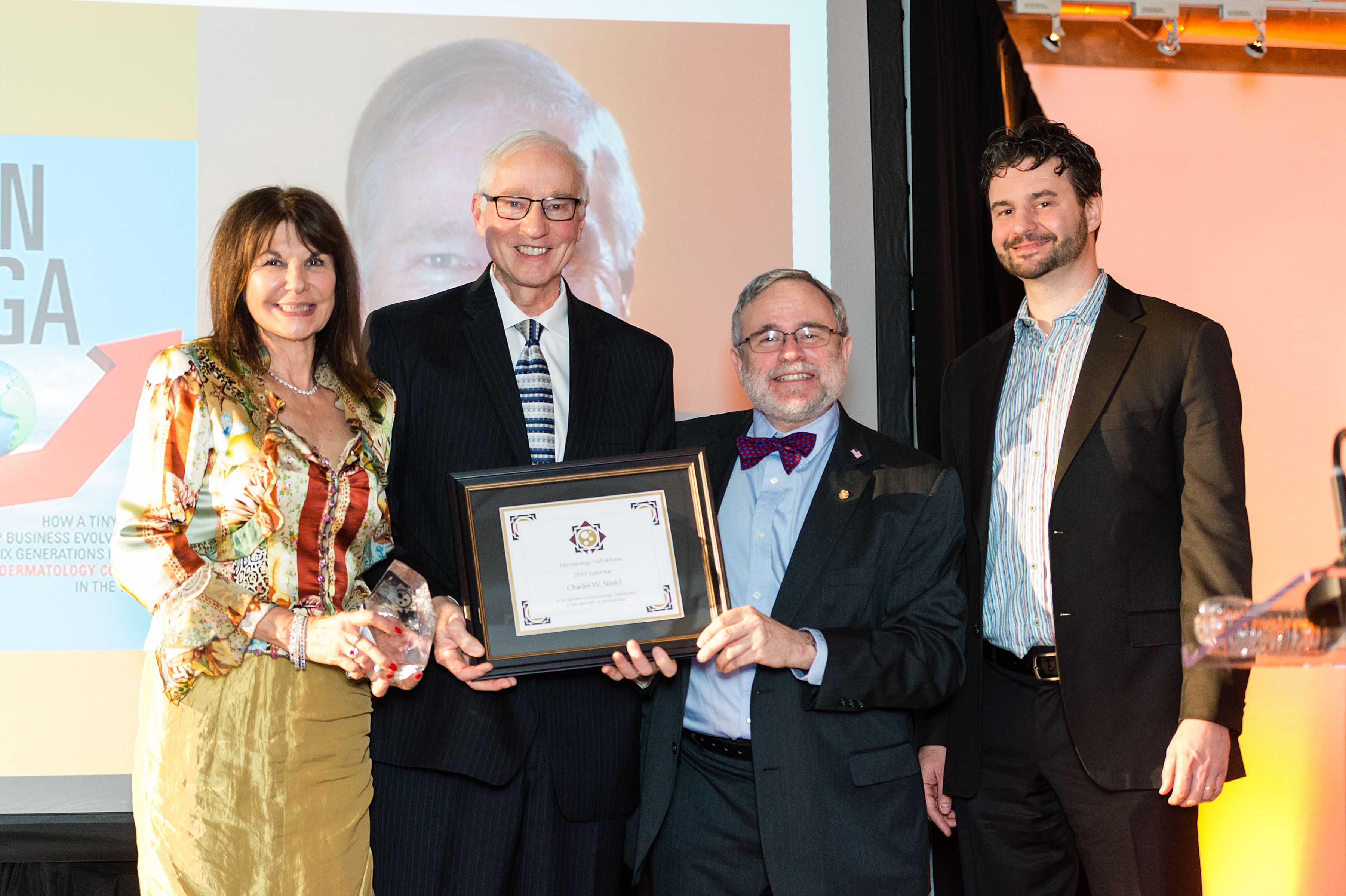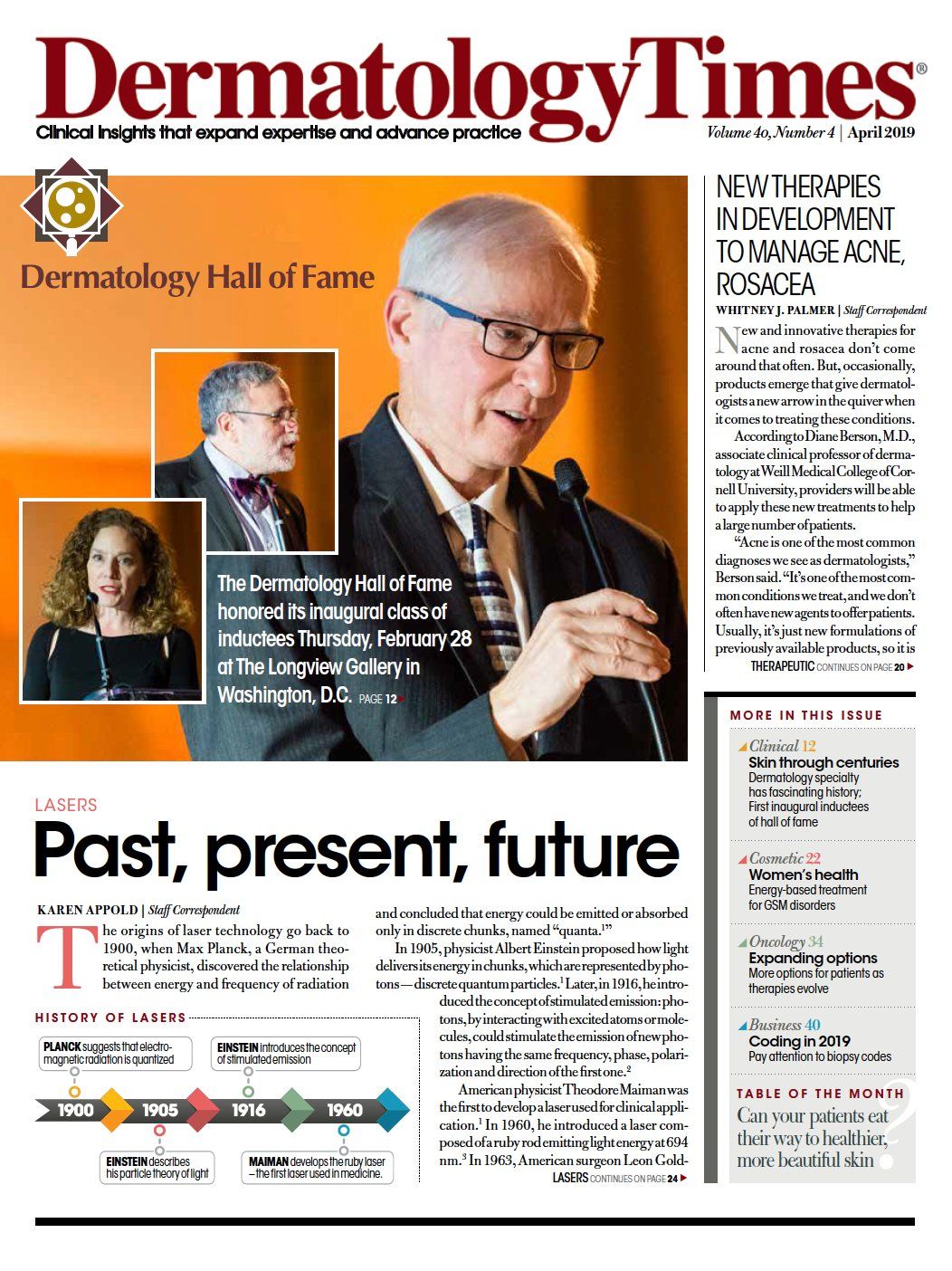- Case-Based Roundtable
- General Dermatology
- Eczema
- Chronic Hand Eczema
- Alopecia
- Aesthetics
- Vitiligo
- COVID-19
- Actinic Keratosis
- Precision Medicine and Biologics
- Rare Disease
- Wound Care
- Rosacea
- Psoriasis
- Psoriatic Arthritis
- Atopic Dermatitis
- Melasma
- NP and PA
- Skin Cancer
- Hidradenitis Suppurativa
- Drug Watch
- Pigmentary Disorders
- Acne
- Pediatric Dermatology
- Practice Management
- Prurigo Nodularis
- Buy-and-Bill
Publication
Article
Dermatology Times
First inductees to Dermatology Hall of Fame announced
Author(s):
Hosted by Dermatology Times and supported by Ortho Dermatologics, the hall of fame honored its inaugural class of inductees at the Long View Gallery in Washington, D.C., just before the 2019 American Academy of Dermatology Annual Meeting.
Charlie Stiefel, former chairman and chief executive officer of Stiefel Laboratories, one of this year’s inductees, has donated a significant amount of money to dermatology research. (L - R: Daneen Stiefel, Charlie Stiefel, Daniel Siegel, M.D., and Todd Stiefel.) (Photos: Lisa Boggs Photography)

Eve Lowenstein, M.D., Ph.D. gave an insightful presentation on the evolution of humility and error awareness in medicine. (Photos: Lisa Boggs Photography)

Daniel Siegel, M.D., announced the honorees in historical order on behalf of the Dermatology Hall of Fame Board of Directors. (Photos: Lisa Boggs Photography)

Sharon Finch, senior vice president and group publisher at Quadrant HealthCom, introduced the Dermatology Hall of Fame and its mission. (Photos: Lisa Boggs Photography)

Inductee Charlie Stiefel, former chairman and chief executive officer of Stiefel Laboratories. (Photos: Lisa Boggs Photography)

The specialty of dermatology has a relatively short, but rich history filled with many fascinating and passionate individuals who have shaped its development. While the path to the establishment of the specialty has woven across continents and centuries, American dermatology has been said to have begun under Henry Daggett Bulkley in the early 1800s. Of all of the many insights into the physicians who paved the way, the thread that seems to weave through each story is spun by fibers of high intelligence, extraordinary dedication and a remarkable compassion. Each one was fervently devoted to the continuing scientific study of dermatology, a high degree of proficiency in practice, and was reportedly held in very high regard by fellow colleagues for their contributions to the discipline as well as their humanity toward contemporaries.
It was against this backdrop that The Dermatology Hall of Fame was established in 2018. Hosted by Dermatology Times and supported by Ortho Dermatologics, the hall of fame honored its inaugural class of inductees at the Long View Gallery in Washington, D.C., just before the 2019 American Academy of Dermatology Annual Meeting. Following an insightful presentation by Eve Lowenstein, M.D., Ph.D., on the evolution of humility and error awareness in medicine, Daniel Siegel, M.D., announced the honorees in historical order on behalf of the Dermatology Hall of Fame Board of Directors.
The 2019 inductees are as follows:
Marion B. Sulzberger, M.D.
Known for his work in immunodermatology1, Dr. Sulzberger was one of the best-known American dermatologists of the 1950s, 60s, and 70s. But, he only discovered his interest in dermatology, specifically dermatologic allergies, after dropping out of Harvard University at age 17 and working his way around the world in a variety of jobs. It wasn’t until he met Bruno Bloch in Zurich that he became fascinated with dermatology.
That interest blossomed and led to more than 400 scientific articles on a variety of cutaneous problems, ranging from sweat gland function to the mechanism of blister formation.2 With Victor Witten, M.D., he published the first papers on corticosteroid use in dermatology.3 As a clinician, with colleagues, he refined the practice of patch testing in the United States.4 Also during those years, he was named director of the New York Skin and Cancer Unit and then chairman of the department of dermatology at New York University.1 Later, he also held a clinical professorship at the University of California at San Francisco.4
He was a founding member of the Society for Investigative Dermatology. Additionally, he served on the first board of directors of the American Academy of Dermatology. He also served as president of the Society for Investigative Dermatology, the American Dermatological Association, and the International League of Dermatologic Societies.2
In recognition of his professional accomplishments, he received the Gold Medal from the American Academy of Dermatology, the Stephen Rothman Medal from the Society for Investigative Dermatology, and the Alfred Marchioni Gold Medal.4
Hermann Pinkus, M.D.
A contemporary of Dr. Sulzberger, this inductee received his medical degree from the University of Berlin School of Medicine in 1929, he studied under histopathologist Joseph Jadassohn and immigrated to the United States in 1934.5
He described many new clinicopathologies, including premalignant fibroepithelial tumors of skin (1953),5,6 eccrine poroma (1956),5,7 and alopecia mucinosa (1957).5,8 Despite some errors in thought, his ideas, overall, prompted other dermatologists to delve more deeply into the basic problems of dermatopathology.5
In 1960, he became professor and chairman of the Wayne State University School of Medicine dermatology department.5 He was a founding member and a president of the American Society of Dermatopathology, president of the Society for Investigative Dermatology, vice president of the American Academy of Dermatology, and vice president of the American Dermatological Association. He also received several national awards from both the United States and Germany.5
Walter F. Lever, M.D.
Another mid-1900 contemporary, this next inductee began his career in the United States as a resident and research fellow at Massachusetts General Hospital in Boston in 1936 where, in part, he attended to patients with advanced pemphigus vulgaris and was introduced to pathology.
He is said to have laid the foundation for the immunodermatology subspecialty through his study of autoimmune blistering diseases.9 He was the first to distinguish bullous pemphigoid from phemphigus vulgaris, dermatitis herpetiformis and other blistering diseases. And, he is best known for his widely read textbook Histopathology of the Skin, which was published in 1949.10
In academia, he reportedly had an infectious enthusiasm about dermatopathology diagnosis and teaching; and, he developed a strong research program at Tuft’s that trained many dermatologists who eventually became leaders in their own rights.10
When he left Massachusetts General Hospital to become the Chair of Dermatology at Tuft’s University Medical School, he was retained by Massachusetts General as a consultant and honorary dermatologist.
He also was a founding member and past president of the American Society of Dermatopathology.11
For more inductees, click to the next page.
Naomi M. Kanof, M.D.
Devoted to the recognition of the role of women in medicine, this inductee was active in a number of specialty societies, including the Washington Dermatologic Society and its prior organization, the Baltimore-Washington Dermatologic Society, the Pennsylvania Academy of Dermatology, the American Medical Association, the Medical Society of the District of Columbia, the American Dermatological Association, and the American Academy of Dermatology.12
In 1980, she was made an honorary member of the American Academy of Dermatology and received the Gold Medal award in 1986.
She is best known for developing the gold leaf treatment for skin ulcers.13,14
She opened her private practice in Washington, D.C., in 1938 where she saw patients until shortly before her death. Throughout her career, she exerted significant influence on dermatology by serving as an editor for several publications. From 1949 to 1967, she was the executive editor of the Journal of Investigative Dermatology, and from 1972 to 1976, she was the editor of the Journal of American Medical Women’s Association. Later, she assumed the role of dermatology editor for Stedman’s Medical Dictionary, compiling two editions between 1976 and 1982.14
Clinically, she was the chairwoman of dermatology at Children’s Hospital in Washington, D.C., a clinical professor at Georgetown University School of Medicine and a dermatology lecturer at Howard University College of Medicine. She also served as the head of the D.C. Medical Board for Dermatology. Her work culminated in the Dermatology Foundation’s award for Practitioner of the Year in 1983.14
Born in Brooklyn, she received her bachelor’s degree from George Washington University and her medical degree from George Washington University School of Medicine.14
Albert M. Kligman, M.D., Ph.D.
"Our specialty knows this next inductee by both his contributions and controversy," noted Dr. Siegel as he announced this inductee, "While some of his pioneering work was overshadowed, it shouldn’t be negated."
Dr. Kligman's list of accomplishments is long, with much of his work instigating new insights, advances in therapy, or new directions in research.15 He championed scientific study through his work and authorship of hundreds of scientific papers,16 and he attracted and educated generations of dermatologists.17
His contributions include a description of the human hair cycle, telogen effluvium, and hot comb alopecia; linking sun exposure with skin aging and identifying the use of tretinoin for use in treating acne and facial aging; the PAS stain for visualizing fungi in tissue; studies on the pathogenesis of acne vulgaris; a maximization test for identifying new contact allergens; and he was also recognized for coining of the terms “photoaging” and “cosmeceuticals.”14,15,16,18,19
In addition, he served on the Board of Directors for the Society of Investigative Dermatology, as well as vice president and then president. He received the society’s Stephen Rothman Memorial Award, among numerous others.
Walter B. Shelley, M.D.
This inductee’s career began when he assumed responsibility for an 80-bed dermatology ward in an Army hospital in McKinney, Texas. This professional start led to a career focused on the details of dermatological diagnosis and treatment.
Dr. Shelley became chair of the department of dermatology at the University of Pennsylvania in 1965 and was a productive writer. In 1956, he co-authored the first major American dermatology textbook, Dermatology, and went on to publish 15 books-the last one being his autobiography published at age 90. He also published over 600 scientific papers in his career. Much of his interest centered on eccrine and apocrine sweat glands, Lagerhans cells, pruritus, and urticaria. He coined the word “keratinocyte,” and named several conditions that he saw in the clinic, such as aquagenic urticaria, piezogenic pedal papules, pincer nails and autoimmune oestrogen dermatitis.
In addition to research and education, he served as president of the American Academy of Dermatology, from which he also received the Gold Medal. He received the Society for Investigative Dermatology Stephen Rothman Medal for Dermatological Research, the Gougerot Medal for excellence in medical writing and the Rose Hirschler Award from the Women’s Dermatological Society.20,21
Thomas B. Fitzpatrick, M.D., Ph.D.
This inductee was considered by many to be the father of modern academic dermatology. Throughout his career, he was prolific in research, education, and clinical care.
As an investigator, he partnered early with fellow dermatologist Aaron B. Lerner, M.D., Ph.D., to explain skin pigmentation. This research led, over time, to roughly 250 publications that advanced the understanding of pigmentation, aging, and skin disorders. The work led him to describe markers of certain neurological disorders and other markers and skin signs of systemic illness, and, with colleagues, he identified and named the melanosome.22
As an educator, he served as professor and head of dermatology at the University of Oregon from 1952 to 1958 when he was recruited to be the youngest professor and then chairman of dermatology at Harvard Medical School. He held this role until 1987, training countless dermatologists. He also published the first multi-authored dermatology textbook on skin and skin disease in 1971.23
As a clinician, he helped define and profile the clinical characteristic of early melanoma, and he advanced screening efforts to detect curable lesions sooner. In partnership with colleagues, he developed the idea of photochemotherapy to treat psoriasis. He also organized sunscreen studies and championed its widespread use. Additionally, he pioneered the use of electron microscopy in skin studies.23
He was a member of more than 20 professional societies both domestically and abroad, including the American Academy of Arts & Sciences and the Institutes of Medicine of the National Academy of Sciences. He was a founding member of the Dermatology Foundation and served as president of the Society for Investigative Dermatology, the Association for Professors of Dermatology, and the International Pigment Cell Society.22,23
In thanks for training Japanese dermatologists, he also received the Order of the Rising Sun in 1987. A testament to his career was the establishment of an endowed chair in his name at Harvard Medical School in 1982. 22
For more inductees, click to the next page.
Albert Bernard Ackerman, M.D.
Considered one of the founding figures in dermatopathology, this inductee is credited with advancing a method of histopathological diagnosis, which imposed order, structure and clarity on the categorization of inflammatory skin diseases.24 With his 1978 book, Histologic Diagnosis of Inflammatory Skin Diseases, he launched an era of “analytic dermatopathology.”25
In 1973, he joined the faculty of New York University School of Medicine, where he built the largest training center for dermatopathology worldwide.26 His lab was one of the first to screen for early signs of Kaposi’s sarcoma, a fatal skin cancer associated with AIDS.27
He was a prolific author of approximately 700 papers and 59 books covering topics. He also launched a website in 1999 - Derm101.com - designed as an online resource for the diagnosis and treatment of skin diseases. Additionally, he served as an expert witness in roughly 200 trials and launched a website in 2003 dedicated to identifying expert witnesses who give unreliable testimony.25
In addition to clinical work, he was also fundamental to the creation of many of dermatology’s long-standing institutions. He was a founding member of the International Society of Dermatopathology for which he became the first president. He also founded two journals - the American Journal of Dermatopathology and Dermatopathology: Practical and Conceptual. 25, 26, 27
In recognition of his clinical, research, and educational accomplishments, he received the American Academy of Dermatology’s Master Dermatologist Award in 2004.25, 26, 27
Stephen I. Katz, M.D., Ph.D.
Born in New York, Dr. Katz earned his medical degree from Tulane University Medical School in 1966 and his doctorate in immunology from the University of London in 1974.
Trained in both internal medicine and dermatology, he joined the dermatology branch of the National Cancer Institute as a senior investigator in 1974. He remained in this position until 2014. During that time, he was integral to research into skin disease immunology, unearthing insights into how skin contributes to both normal and aberrant immune function. His specific area of research was the pathogenesis of rheumatoid arthritis and lupus. In this role, he also trained immunodermatologists throughout the United States, Japan, Korea, and Europe.
In 1995, he became director of the National Institute of Arthritis and Musculoskeletal and Skin Diseases, a position he held until his death.
He also served many societies in leadership positions, including president for the Society of Investigative Dermatology in 1994. His leadership led to several accolades during his career, including the American Academy of Dermatology Master Dermatologist Award & Sulzberger Lecture Award, Order of the Rising Sun, Gold Rays with Neck Ribbon from the Japanese emperor, two Meritorious Rank Awards, and Distinguished Executive Presidential Rank Award, among many other recognitions.
He also received the 2015 International League of Dermatological Societies Global Dermatology Achievement Medal and served as the secretary-general of the 18th World Congress of Dermatology.28,29,30,31
Charles W. Stiefel
This inductee has carried on his family’s six-generation tradition, serving from 2001 to 2009 as chairman and chief executive officer of Stiefel Laboratories, founded in 1847. The company was the world’s largest privately-held pharmaceutical company specializing in dermatology until it was sold to GSK. Charles recently published a book, Skin Saga, which recounts the Stiefel story.
In addition to this leadership position, he has donated a significant amount of money to medical research. In 2013, he donated $1.3 million to Duke University Medical Center to study infectious diseases and lymphoma and $1 million to the Dermatology Foundation to advance research in autoimmune and connective tissue diseases to identify better treatments and better understand their connection to cancer. He and his wife Daneen donated another $1 million to the Derm Foundation last year to advance skin cancer research. He also established four $100,000 research awards through the American Skin Association for melanoma investigations.
He received his bachelor’s degree from Yale University in 1972 and his law degree from Albany Law School in 1975. He received the South Florida Dermatology Foundation Lifetime Achievement Award in 2003, the American Academy of Dermatology Distinguished Service Award in 2007, and several other lifetime achievement awards for service to dermatology.
He currently serves as chairman of the Board of Directors for Brickell Biotech, Inc.32,33
"I'm incredibly honored and humbled for my name to even be thought of on the same day as these legends of dermatology that we just heard about. I had the pleasure of meeting almost every one of these giants – and some of them I got to know quite well. It was really the highlight of my life knowing some of these people,” said Stiefel upon receiving the award. “I’d like to thank the Board of Directors for all the hard work they did. I’d also like to thank the sponsor of this event, which I look forward to attending every year.”
References:
1. https://www.nytimes.com/1983/11/25/obituaries/dr-bm-sulzberger-dermatology-expert-held-post-at-nyu.html
2. A memorial to Marion Baldur Sulzberger, MD. Arch Dermatol. 1984;120(7):857-858
3. Sulzberger MB, Witten VH. The effect of topically applied compound F in selected dermatoses. Journal of Investigative Dermatology 1952;19:101–2.
4. https://www.the-dermatologist.com/article/improving-patch-test-efficacy
5. https://www.derm101.com/dpc-archive/january-march-2006-volume-12-no.1/dpc1201a20-hermann-pinkus-an-appreciation-on-the-occasion-of-his-100th-birthday/
6. Pinkus H. Premalignant fibroepithelial tumors of skin. Arch Dermatol.1953; 67: 598-615.
7. Pinkus H, Rogin JR, Goldman P. Eccrine poroma. Tumors exhibiting features of the epidermal sweat duct unit. Archives of Dermatology 1956; 74: 511-521.
8. Pinkus H. Alopecia mucinosa. Inflammatory plaques with alopecia characterized by root sheath mucinosis. Arch Dermatol. 1957; 76: 419-426.
9. http://www.dysimmunefoundation.com/wp-content/uploads/2015/04/Walter-F.-Lever-Memorial-Lecture-Award.pdf
10. Duncan LM, Mihm MC Jr. Dermatopathology. In: Louis DN, Young RH eds. Keen Minds to Explore the Dark Continents of Disease: A History of the Pathology Services at the Massachusetts General Hospital. Boston, MAMass. General Hospital; 2011
11. https://www.asdp.org/about-asdp/history/
12. https://core.ac.uk/download/pdf/82456268.pdf
13. https://www.jaad.org/article/S0190-9622(81)80184-3/pdf
14. https://www.washingtonpost.com/archive/local/1988/06/28/naomi-m-kanof-76-dermatologist-dies/c0e54f12-b243-412f-bcd0-034d570b9a78/?utm_term=.4bb04f4799fe
15. Leyden JJ. Arch Dermatol. 1991;127(9):1392-1393.
16. https://www.nytimes.com/2010/02/23/us/23kligman.html
17. Plewig G. Arch Dermatol. 1991;127(9):1415-1416.
18. https://www.ncbi.nlm.nih.gov/pmc/articles/PMC3002422/
19. http://www.upenn.edu/emeritus/memoriam/Kligman.html
20. http://www.bad.org.uk/library-media%5Cdocuments%5CDr%20Walter%20Shelley.pdf
21. https://www.legacy.com/obituaries/toledoblade/obituary.aspx?n=walter-b-shelley&pid=123744516
22. https://jamanetwork.com/journals/jamadermatology/fullarticle/479610
23. https://news.harvard.edu/gazette/story/2005/09/thomas-b-fitzpatrick/
24. https://www.mdedge.com/dermatology/article/8935/health-policy/dermatopathologist-bernie-ackerman-dies-72
25. https://www.intsocdermpath.org/assets/docs/History/a__bernard_ackerman_1936_2008.3%202.pdf
26. https://www.jaad.org/article/S0190-9622(09)00087-5/pdf
27. https://www.nytimes.com/2008/12/11/health/11ackerman.html
28. https://www.niams.nih.gov/about/directory/stephen-i-katz-md-phd
29. https://www.nih.gov/about-nih/who-we-are/nih-director/statements/mourning-loss-niams-director-stephen-katz-md-phd
30. https://www.niams.nih.gov/newsroom/announcements/niams-mourns-loss-dr-steve-katz
31. https://www.medscape.com/viewarticle/907069#vp_1
32. https://www.bizjournals.com/triangle/blog/2013/08/raleighs-charles-and-daneen-stiefel.html
33. https://dermatologyfoundation.org/articles/stiefelarticle.pdf






